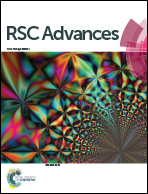Amazing selectivity for Am(iii) uptake by composite graphene oxide-PES polymeric beads prepared by phase inversion
Abstract
Novel polyethersulphone (PES) based polymeric beads containing graphene oxide (GO), prepared by a phase inversion technique for the first time, were evaluated for actinide ion uptake from acidic feed solutions. The actinide ions studied were Am3+, Pu4+, Th4+, UO22+ while Eu3+ was taken as a representative trivalent lanthanide ion. The feeds used for the uptake studies were unbuffered aqueous pH solutions and the observed trend was: Am3+ ∼ Eu3+ ≫ UO22+ ∼ Th4+ > Pu4+. The results were highly encouraging as Am3+ uptake was very high at pH ∼ 5 suggesting that the GO beads can be used for the remediation of low acidic radioactive effluents containing Am3+ ions. The metal sorption capacity for Am(III) at pH 4.0 was found to be 1.22 ± 0.07 mg g−1 of the GO resin whereas the qmax (the maximum predicted sorption capacity) obtained from the Langmuir isotherm was 1.72 ± 0.07 mg g−1 of the GO resin. The sorption isotherm analysis was done by fitting the batch uptake data to the Langmuir, D–R and Freundlisch models. Column studies carried out with the GO-PES beads showed a breakthrough of Am(III) beyond 4 mL. Elution profiles were obtained using 0.1 M HNO3 and about 20 mL was required for quantitative elution.


 Please wait while we load your content...
Please wait while we load your content...